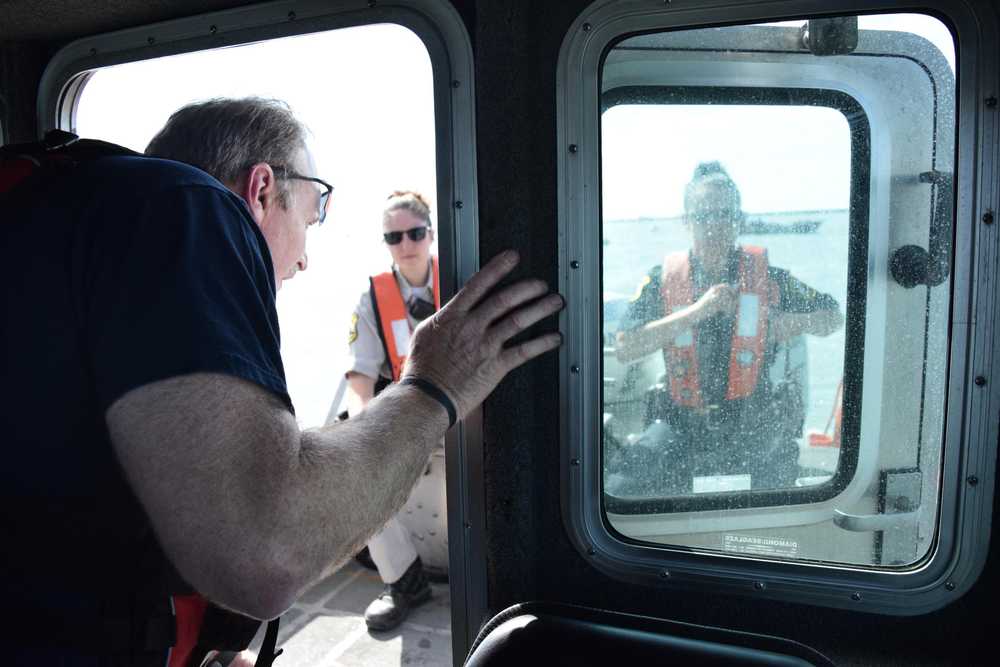Freshly outfitted with a hose for firefighting capabilities, the Kenai Fire Department’s 22-foot, rigid-hull patrol boat handles well while zipping through the waters of the Kenai River.
During the no-wake patrols performed by the department along with Kenai Police Department officers throughout the Kenai River personal-use dipnet fishery, the vessel is out to make sure other boaters are moving more slowly.
The city of Kenai enforces a no-wake zone in the immediate vicinity of the Kenai City Dock and between river miles 3 and 5 on the southern bank of the river in an effort to slow the effects of riverbank erosion from the combination of high tides and a deluge of dipnetters. Complaints have been coming in from the residents with property along those banks, said Kenai Fire Battalion Chief Tony Prior.
While the no-wake zone is in effect around the clock, according to a 2016 informational flyer from the city, any tide above 20.5 feet triggers a patrol, Prior said.
“We just make sure they’re not under power or up on step when they come into the wake zone,” said Kenai Police Officer Morgan Ezell, who participates in no-wake patrols. “What we look for too is, up the river in front of the residential area, we make sure that people are … coming into and going out of the wake zone not under power, so they’re not causing any problems for the bank.”
Ezell joined Prior, fellow firefighter Justin Horton and Temporary Enforcement Officer Morgan Wensley on the first no-wake patrol of this year’s dipnet season last Tuesday. Prior and Horton took turns navigating the Kenai River while Ezell and Wensley looked out for potential rule-breakers. Firefighters are there to maneuver the boat, and they volunteer for patrols via a signup sheet as they are not part of regular duties, Horton said.
In the years since the city implemented the no-wake zone, boaters who are regulars at the dipnet fishery have gotten better about anticipating it, Ezell said. Often, officers will simply issue warnings when they come upon vessels not obeying the rules. Officers can hand out citations from the boat, but those are usually reserved for repeat offenders, Ezell said.
“If we’ve contacted them multiple times during the day, then usually we’ll give them a citation,” she said. “If not, if it’s kind of a one-and-done, then we usually just go with a verbal warning.”
Boaters are generally unaware they are in the no-wake zone rather than intentionally ignoring it, Prior said. Eager dipnetters are focused on looking around the river for good spots and other boats on the move, Prior said, so they sometimes don’t spot the buoys that signal the zone’s perimeter.
Cracking down on the no-wake zone not only helps alleviate some of the erosion the banks undergo but is also a matter of public safety, Prior said. It doesn’t take a very large wake to capsize one of the smaller boats zipping in and out between the others, especially during low tide, Prior said.
“You’ve got a narrow lane, and you’ve got a hundred and some boats that are out here,” he said. “There’s only so much room for them, and it doesn’t take much of a wake for those small ones.”
It is important for dipnetters to heed the weight limit for their vessels, whether they be large or small, Prior said. An overloaded boat increases the chances of capsizing.
Both larger fishing vessels and smaller boats clog the river and its mouth throughout the personal use fishery each July, and they all have to share space with the even larger commercial fishing vessels. Knowing how to share the space can be complicated, Prior said.
“They’re coming up the river like this to go to their moorings, too,” he said of commercial fishing boats. “And a big boat makes a big wake — I mean, that’s just all there is to it. And when it’s a lower tide, there’s not as much room for them to go, but they still need to get up to their mooring, you know, so everybody needs to kind of work with each other.”
Members of the Kenai Fire and Kenai Police Departments responded to a small capsized boat the morning of the no-wake patrol, the first one Prior said he knows of this dipnet season. It went down after taking on water from a wake, and all four occupants had to be towed, uninjured, back to shore along with the 18-foot low boat. On Friday, Kenai Fire, Kenai Police and the U.S. Coast Guard helped out another capsized vessel carrying three people, who were saved by a neighboring boat and towed around by Kenai Fire’s patrol boat until their vessel could be bailed out.
“Even these guys, they’re in a race to get back up to their spot,” Prior said. “So the personal use guys don’t realize every time that they’re going up, they’re creating a big wake that stresses the mooring buoys of the commercial fishermen too, so, you know, it’s a give and take with each other. If there’s anything that’s a benefit for either side … the slower they go, either one of them, the better they’re going to be — more courteous for each other.”
Reach Megan Pacer at megan.pacer@peninsulaclarion.com.

